- NLI Research Institute >
- Leading-Edge Employment Reforms in the Information Technology Sector - The Nissay Survey of Business Conditions (First Half of FY 1997) -
Leading-Edge Employment Reforms in the Information Technology Sector - The Nissay Survey of Business Conditions (First Half of FY 1997) -
the Industrial Research Dept.
Font size
- S
- M
- L
1. Business Conditions in the Booming IT Sector
As seen by the introduction of corporate LANs, Internet boom, and explosive growth in cellular phones, advances in information technology (IT) show no signs of abating as companies continue to increase investment in IT.
Reflecting this business environment, our survey found that the IT sector−including information services, communications, and electric machinery−continues to grow vigorously even as overall business conditions deteriorate (Figure 1). The survey also revealed that against the backdrop of this strong business sentiment, the IT sector is at the forefront of reforming its employment system with modifications to wage and management structures such as the introduction of merit-based pay and use of outside employment agencies for staffing needs.
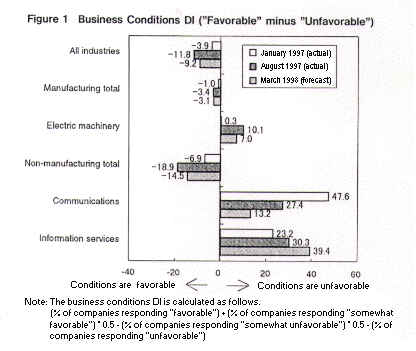
2. Improvement in Hiring Intentions
(1) Hiring Intentions Vary Widely by Sector
The all-industry diffusion index for change in number of employees improved to 15.1 in April 1997, from 11.2 in April 1996 (January 1997 survey). The DI for change in employment is calculated as the percentage of companies who increased their payrolls minus the percentage who decreased their payrolls; a higher DI indicates a stronger hiring intention. However, the improvement was not shared equally by all sectors (Figure 2).
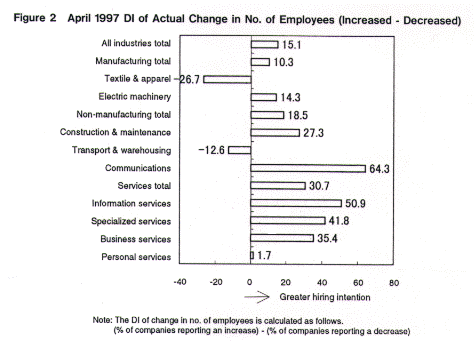
Many sectors with strong employment DI's are in the non-manufacturing sector, particularly in the vigorous IT industries such as communications and information services. On the other hand, hiring intentions in the manufacturing sector are relatively low, with large negative values for textiles & apparel. Transport & warehousing in the non-manufacturing sector is negative as well.
In addition, hiring intentions are strong overall in the service sector, which accounts for one-fourth of all employees. However, differences exist even in this sector−information services and other services that cater to corporate users are strong, but personal services are weak due to the slump in personal spending.
In construction, which along with the service sector has been absorbing employees from other sectors, a decline is expected as public spending cuts begin to take effect.
By region, DI's declined in Kyushu, Chugoku, Shikoku and Hokkaido, reflecting the poor business sentiment in these areas (Table 1).
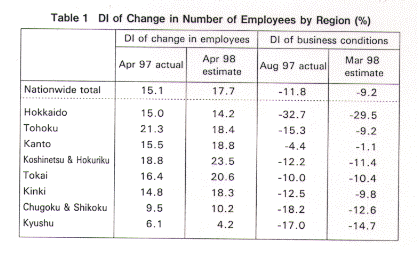
(2) IT Sector's Hiring Intentions to Remain Steady in Fiscal 1998
Looking ahead to the employment DI for April 1998, the all-industry DI continues to improve slightly to 17.7 (estimate).
However, sectoral differences remain pronounced, with IT industries such as information services and communications remaining strong, while textile & apparel, transport & warehousing continue to slump.
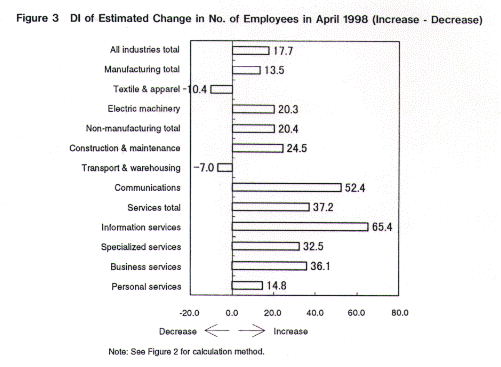
3. Primary Problem: Securing Good Personnel
(1) Dissatisfaction Grows in Quality of Personnel
Looking at employment trends over the past year, the majority of companies could not fulfill their hiring needs quantitatively, with 8.8 percent unable to fill their planned job hirings. However, while the proportion of companies who were able to hire the quality of personnel they sought fell five percentage points from the previous survey (September 1996) to 20.4 percent, the proportion of companies who could not hire the personnel they had hoped for rose 8.1 percentage points to 28.3 percent. This indicates the growing difficulty of finding high-quality personnel.
Looking at the personnel for whom hiring increased, 36.5 percent hired more young personnel expected to information needs and global economy, while only 8.9 percent hired more women.
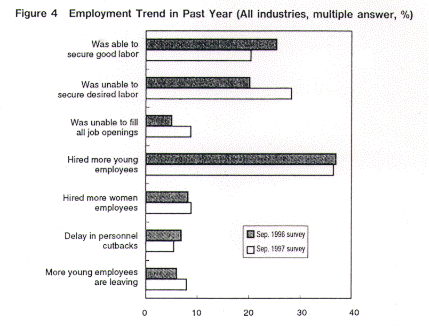
(2) Young, Talented Personnel Prefer IT Sector
By sector, in information related industries such as communications and information services as well as robust industries such as specialized services, many companies report increases in hiring of young personnel and a sufficient supply of good personnel.
This condition reflects the superior position in hiring activities enjoyed by information related industries due to their rising stature as leading-edge growth industries, and to an increasingly specialist orientation among younger people as seen by the boom in acquiring job-related qualifications.
However, a large proportion of companies in information services and specialized services also reports being unable to secure the desired personnel, indicating a diversity of conditions even within the same industry. From this we can infer that competition is intensifying within these industries in the acquisition of personnel.
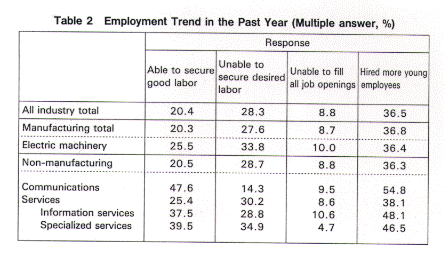
(3) Shortages in Quality and Quantity of Personnel in Information Services
Due to difficulties in securing quality personnel, approximately half (49.0 percent) of the companies cite securing good personnel as a current problem in the area of employment. In addition, compared to the previous survey, a larger proportion of companies cite the aging of employees (29.1 percent) and rising personnel costs (28.4 percent) as problems.
By sector, the problem of securing good personnel is cited most frequently by information services (70.2 percent) and specialized services (69.8 percent), while aging of employees is cited by transport & warehousing (42.6%), and rising personnel costs by food products (36.2 percent). Although information services and specialized services enjoy an edge over other industries in hiring, they are also under constant pressure to seek quality personnel due to the rapid pace of technological change and increasingly complex user needs.
In addition, the information service industry also stands out for the high proportion of companies citing labor shortages (21.2 percent). Considering the increase in demand related to the "year 2000 problem" of computers, we can infer that future labor shortages will involve not only the quality but quantity of labor.
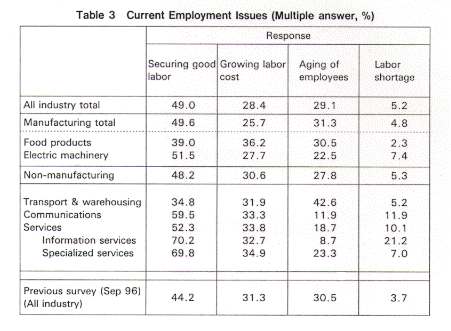
4. Reevaluation of Employment and Personnel Systems
(1) Employment and Personnel Reforms Arising from Personnel Cutbacks
Regarding new employment and personnel measures implemented in the past year or planned in the next year (all industries), the most commonly cited measures were review of wage structures (39.9 percent), and enhancement of education and training (34.2 percent), followed by the review of management structures (21.7 percent). The proportion of companies citing these measures has been rising for the past three years (Figure 5).
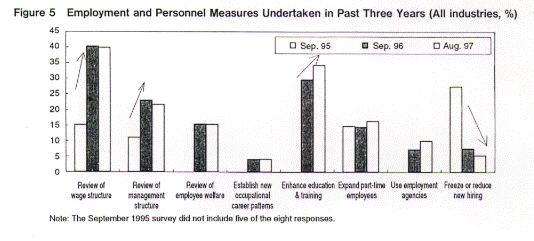
On the other hand, the proportion of companies reducing or freezing new hiring has declined over the past three years. This appears to reflect a shift in emphasis of employment and personnel measures away from employment adjustments such as personnel cutbacks, and toward systematic enhancements aiming to secure and develop good personnel, and the reevaluation of Japanese employment practices such as lifetime employment and seniority-based pay structures.
With regard to other measures, the use of employment agencies rose 2.8 percentage points from the previous survey to 10.1 percent, while greater use of part-time employees rose 1.9 percentage points to 16.5 percent. These results indicate that companies are cautious not to increase their fixed labor costs, and that the types of available employment are diversifying.
(2) Growth of Merit-Based Pay
Turning to changes in wage systems (all industries), 26.2 percent have introduced company-wide merit-based pay systems(or will do so within one year), while 13.3 percent have partially introduced merit-based pay for some job classifications. Thus approximately 40 percent of companies have introduced (or decided to introduce) merit-based pay systems.
With only 24.5 percent of companies not planning to introduce merit-based pay, the once prevalent seniority-based pay system appears to be steadily losing ground.
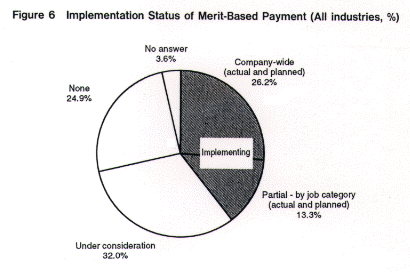
(3) IT Sector Leads in Employment System Reforms
These reforms in employment and pay systems are being led by the IT sector. Many companies in specialized services (46.5 percent) are reviewing wage structures, while 45.5 percent in electrical machinery and 37.2 percent in information services are reviewing management structures). Elsewhere, communications (40.5 percent) and information services (20.2 percent) are particularly active in the use of employment agencies, while information services are setting up new occupational career patterns (10.6 percent).
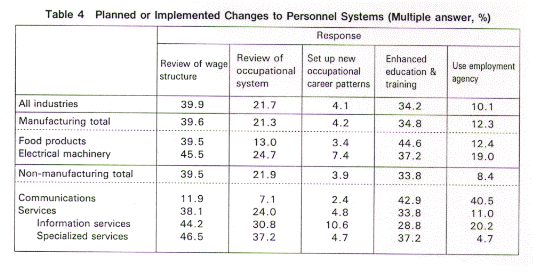
Information services and specialized services are far ahead in the company-wide introduction (actual and planned) of merit-based pay, exceeding 40 percent (Figure 7). In particular, the proportion in information services exceeds 60 percent if partial introduction is included.
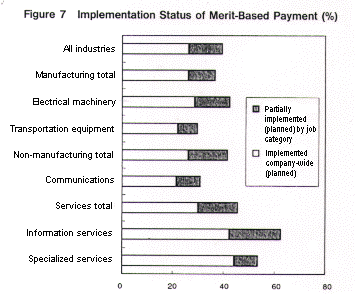
According to industry sources, in recent years the information services industry has become known for its high labor mobility including a rising proportion of mid-career hiring, and progressive work conditions such as flex time (Figures 8 and 9).
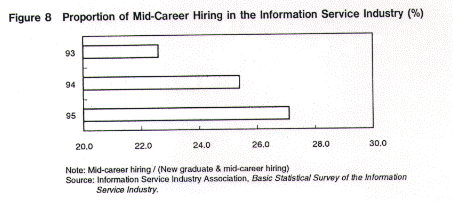
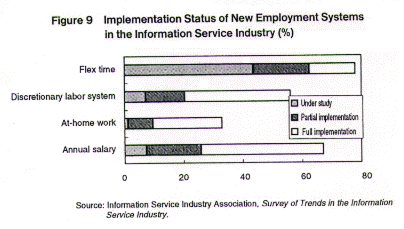
In today's IT product and services markets, the demand shift from mainframes to personal computers and expansion in volume due to growing corporate IT investment budgets are occurring simultaneously. In the main information service segment of software development, which is particularly labor intensive and requires specialized skills, the availability of labor in sufficient quality and quantity is directly linked to corporate competitiveness. According to the Information Service Industry Association's "Information Service Industry Basic Statistical Survey," the industry's ratio of labor cost to sales was 35.6 percent in fiscal 1995, compared to 13.6 percent for all industries (MOF, Annual Statistics of Incorporated Enterprises).
Given this business environment, the employment and pay system reforms identified in our survey appear to be becoming increasingly prevalent as IT companies compete in the labor market.
In the U.S., the information revolution is creating a high-growth "new economy" based on rising productivity, and employment related indexes have been performing well. In Japan, on the other hand, progress in implementing information technology and carrying out deregulation and other structural reforms have yet to bring about a full-fledged recovery in the employment environment. In addition, the decline in the younger population segment portends labor shortages in the future.
Our survey results indicate that the IT sector, a leading sector of the economy, is moving ahead of other sectors in implementing employment system reforms to overcome the problems of the employment environment. We predict that the developments occurring today in the IT sector will spread to other sectors and lead to a significant alteration of the overall employment system in Japan.
the Industrial Research Dept.
Research field
レポート紹介
-
研究領域
-
経済
-
金融・為替
-
資産運用・資産形成
-
年金
-
社会保障制度
-
保険
-
不動産
-
経営・ビジネス
-
暮らし
-
ジェロントロジー(高齢社会総合研究)
-
医療・介護・健康・ヘルスケア
-
政策提言
-
-
注目テーマ・キーワード
-
統計・指標・重要イベント
-
媒体
- アクセスランキング

















